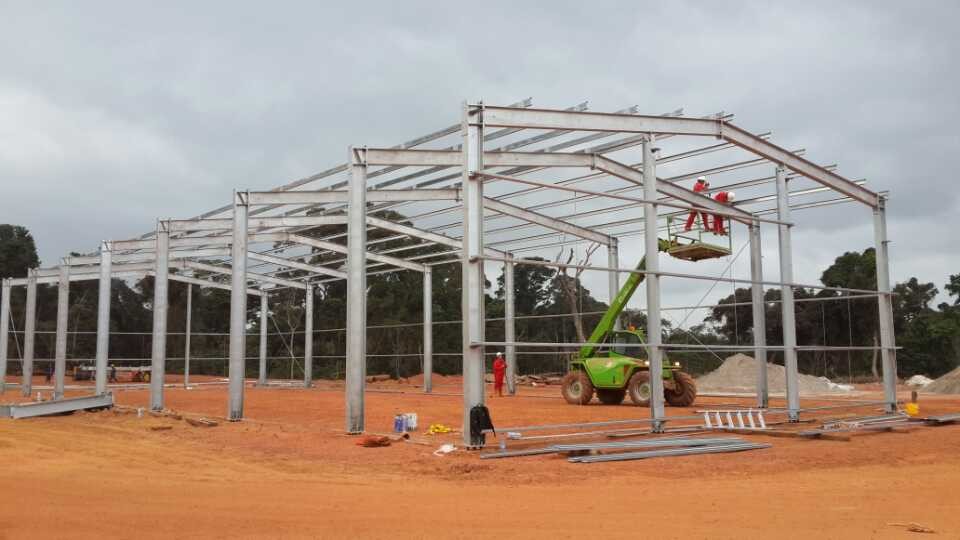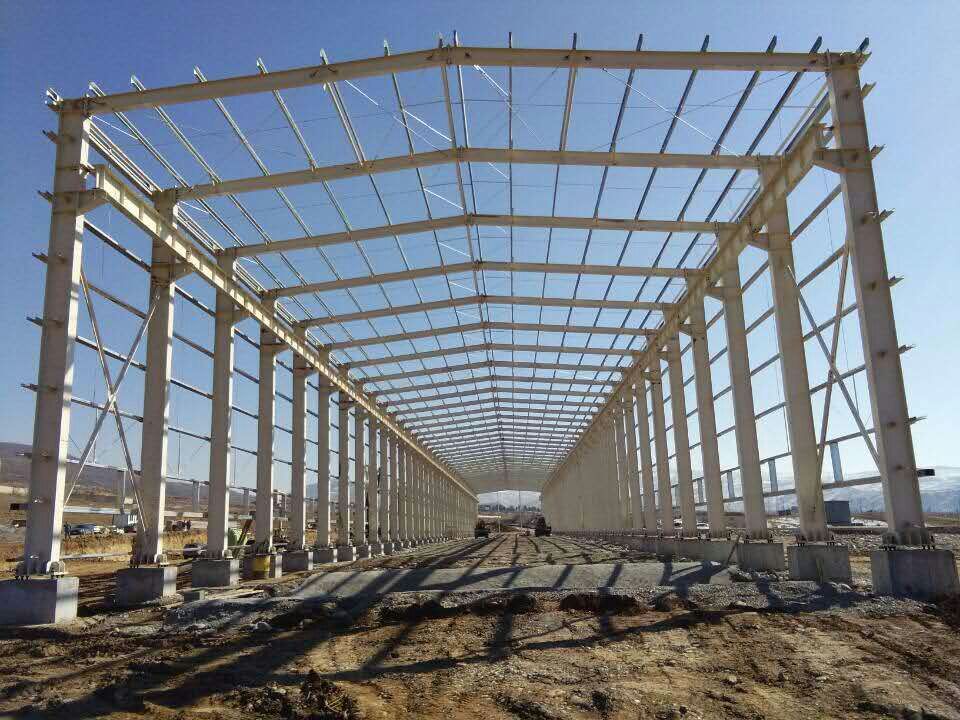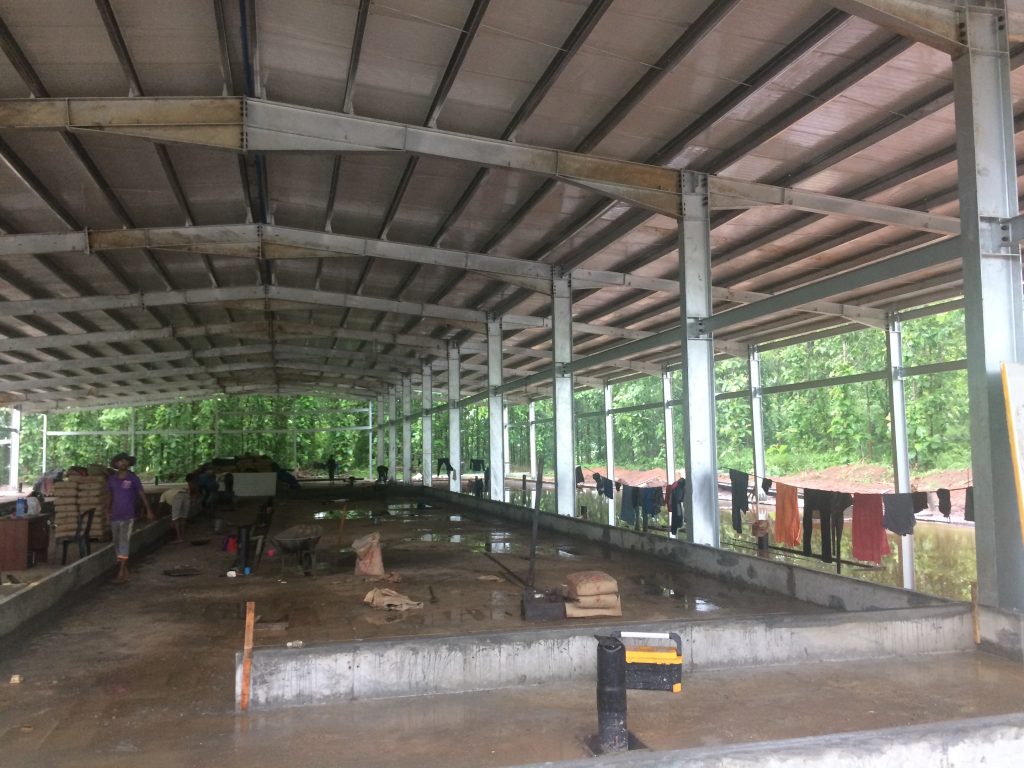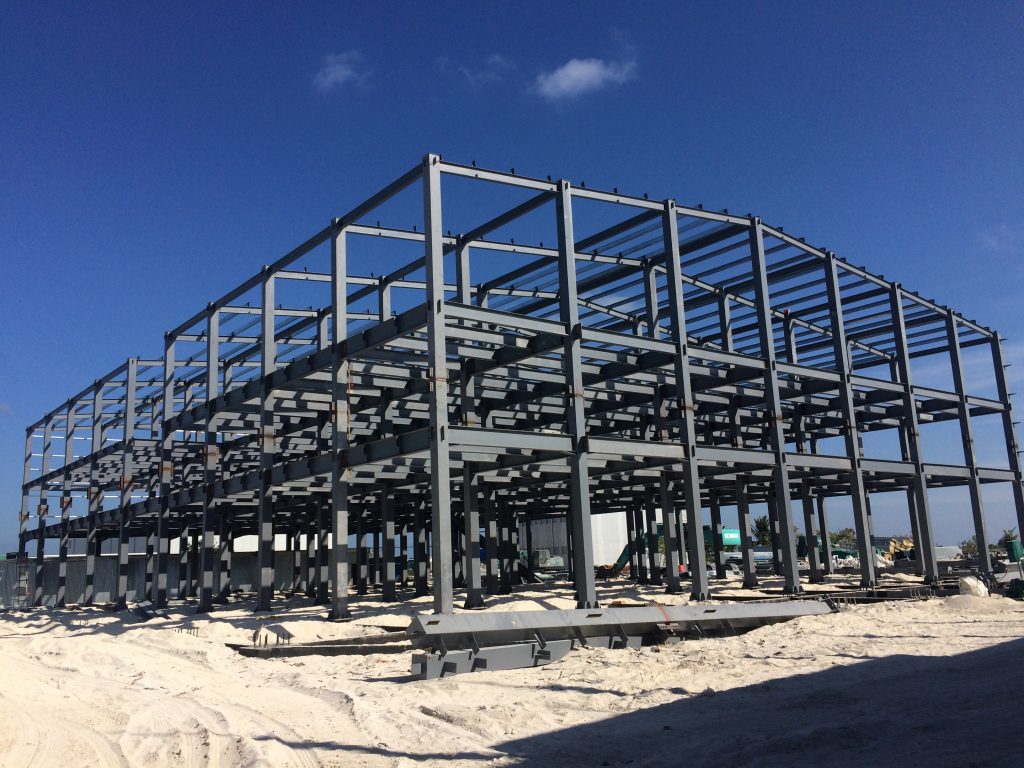Lida Group Integrates Smart Building Technologies into Its High Quality Metal Buildings Using Advanced Prefab Steel Frames
2025-Oct-16 17:58:13
By Admin
The global construction industry is undergoing a paradigm shift: as urbanization accelerates and sustainability goals tighten, businesses and communities demand buildings that are not just durable and cost-effective, but also intelligent. Smart buildings—equipped with sensors, automation, and data-driven systems—promise to reduce energy use, enhance operational efficiency, and improve user comfort. However, integrating smart technologies into traditional construction (e.g., concrete, on-site steel) often faces barriers: rigid structures that limit sensor installation, high retrofitting costs, and poor compatibility between hardware and software.
Lida Group, a global leader in advanced prefabricated (prefab) steel structure construction since 1993, has solved this challenge by designing its high quality metal buildings with smart integration as a core feature—rather than an afterthought. Leveraging its proprietary prefab steel frames (engineered for strength, precision, and adaptability), Lida embeds IoT (Internet of Things) sensors, AI-driven control systems, and BIM (Building Information Modeling) compatibility directly into the building’s structure during factory production. The result is a new generation of smart metal buildings that deliver the durability of Lida’s premium steel frames, the efficiency of prefab construction, and the intelligence of modern smart systems. Operating in 110+ countries, these buildings serve diverse sectors: from smart factories and warehouses to intelligent residential complexes and commercial hubs. This article explores how Lida’s integration of smart technologies and advanced prefab steel frames redefines what high quality metal buildings can achieve.

1. The Foundation: Advanced Prefab Steel Frames—Built for Smart Integration
Lida’s ability to seamlessly integrate smart technologies begins with its advanced prefab steel frames—engineered to address the unique needs of smart building systems. Unlike traditional on-site steel or concrete structures (which often require destructive retrofitting for sensors or wiring), Lida’s prefab frames are designed with “smart-ready” features during factory production, ensuring compatibility, accessibility, and long-term reliability.
1.1 Precision Manufacturing: The Backbone of Smart Compatibility
Lida’s prefab steel frames are manufactured in ISO 9001-certified factories using CNC (Computer Numerical Control) machines with ±0.1mm precision—far exceeding the tolerance of on-site construction (±2mm). This precision allows for the integration of standardized “smart channels” (hollow steel sections) within frames, designed to house sensors, wiring, and data cables. For example, Lida’s “SmartFrame” system includes 20mm-diameter channels in roof trusses and wall columns, pre-drilled at 500mm intervals to accommodate IoT sensors (e.g., temperature, humidity, vibration). These channels eliminate the need for drilling or cutting on-site—preventing structural damage and ensuring sensors are installed in optimal locations (e.g., load-bearing points for vibration monitoring).
Precision also ensures consistent spacing for smart hardware. Lida’s floor frames, for instance, include pre-welded mounting brackets for smart lighting fixtures and HVAC (Heating, Ventilation, and Air Conditioning) vents—aligned to within 0.2mm of design specifications. This consistency reduces installation time for smart systems by 40% compared to traditional buildings, where workers often need to adjust hardware to fit irregular structures.
1.2 Material Innovation: Durability for Long-Term Smart Operation
Smart buildings require systems that operate reliably for decades—so Lida’s prefab steel frames are engineered for exceptional durability, ensuring smart components remain protected and functional. The company uses two core steel alloys tailored for smart integration:
- Q355B-H HSLA Steel: A high-strength low-alloy steel with 490 MPa tensile strength, used for load-bearing frames. Its corrosion resistance (enhanced by a three-layer zinc-epoxy-polyester coating) protects embedded sensors from moisture and chemical damage—critical for industrial or coastal smart buildings.
- 316L Stainless Steel: Used for exposed smart components (e.g., exterior sensor housings, data cable connectors), this alloy resists saltwater, industrial dust, and UV radiation 10x better than carbon steel. In a 5-year test of Lida’s coastal smart warehouse in Thailand, 316L sensor housings showed 0% corrosion, while carbon steel housings in nearby buildings failed after 2 years.
Lida’s frames also feature “vibration-dampening joints” (made of rubber-steel composites) that reduce structural shaking—preventing sensor misalignment or damage in high-traffic areas (e.g., smart factories with heavy machinery). Laboratory tests show these joints reduce vibration transmission by 65%, ensuring sensors maintain accurate readings even in dynamic environments.
1.3 Modular Design: Flexibility for Smart System Scaling
Smart technologies evolve rapidly, so Lida’s prefab steel frames are designed to accommodate upgrades without major reconstruction. The company’s modular frame system includes 85% standardized components that can be easily modified to add new smart features (e.g., solar panels, AI-driven security cameras). For example, Lida’s “Add-On Smart Modules” (10m×20m steel frames) come pre-equipped with sensor channels and power ports, allowing businesses to expand their smart warehouse or factory by 200㎡ and integrate new systems (e.g., automated conveyor belts) in 1–2 weeks—no structural overhauls needed.
This flexibility is critical for growing businesses: a Vietnamese e-commerce firm, for instance, added 3 smart modules to its Lida warehouse in 2023 to support new inventory-tracking sensors and robotic pickers. The expansion took 10 days and cost $85,000—30% less than retrofitting a traditional concrete warehouse with the same systems.

2. Smart Building Technologies: Integrated into Every Layer of Lida’s Metal Buildings
Lida does not just “add” smart technologies to its prefab steel buildings—it embeds them into the structure’s DNA, creating a unified system where frames, sensors, and software work in harmony. Below are the four key smart technologies integrated into Lida’s high quality metal buildings, along with their real-world benefits.
2.1 IoT Sensor Networks: Real-Time Data for Proactive Management
Lida’s prefab steel frames serve as the backbone for dense IoT sensor networks, collecting data on everything from structural health to energy use. These sensors are installed during factory production—either embedded in steel channels or mounted on pre-welded brackets—ensuring optimal placement and protection.
2.1.1 Structural Health Monitoring (SHM) Sensors
For industrial or high-rise metal buildings, Lida integrates fiber-optic strain sensors (embedded in load-bearing columns) and vibration sensors (mounted on roof trusses) to monitor structural integrity in real time. These sensors measure:
- Strain: Detects excessive load on beams or columns (e.g., from heavy machinery in smart factories) with a precision of ±1 microstrain.
- Vibration: Alerts to abnormal shaking (e.g., from nearby construction or machinery imbalance) that could damage the frame.
- Corrosion: Electrochemical sensors embedded in steel frames track rust formation, sending alerts when coating degradation exceeds 5%.
In Lida’s smart factory for a German automotive supplier, SHM sensors detected a 12% increase in strain on a floor beam due to a misaligned 5-ton forklift. The system sent an alert to facility managers, who adjusted the forklift’s path—preventing beam damage that could have cost $25,000 in repairs. Over 3 years, the SHM system reduced unplanned maintenance by 40%.
2.1.2 Environmental and Energy Sensors
For commercial and residential smart buildings, Lida integrates sensors to optimize comfort and energy use:
- Temperature/Humidity Sensors: Placed in wall cavities and ceiling trusses, these sensors monitor indoor conditions with ±0.5°C/±2% RH accuracy, adjusting HVAC systems to maintain optimal levels.
- Light Sensors: Mounted on exterior steel panels, they detect natural light and dim artificial lighting—reducing energy use by 25% in Lida’s smart office building in Malaysia.
- Energy Meters: Embedded in electrical conduits within steel frames, these sensors track real-time energy consumption for individual zones (e.g., factory production lines, warehouse storage areas), identifying inefficiencies.
A Lida smart retail center in Kenya uses these sensors to adjust HVAC and lighting based on foot traffic. During peak hours (12–3 PM), the system increases cooling and brightens lights; during slow periods, it reduces energy use by 30%—saving the center $1,200 monthly in electricity costs.
2.2 AI-Driven Control Systems: Automating Efficiency and Comfort
Data from Lida’s IoT sensors is processed by the company’s proprietary AI platform—“LidaSmart AI”—a cloud-based system integrated into the building’s prefab steel frames via pre-installed Ethernet ports. LidaSmart AI uses machine learning to automate operations, predict maintenance needs, and optimize resource use—all without human intervention.
2.2.1 Energy Management Automation
LidaSmart AI’s most impactful feature is its ability to optimize energy use across all building systems. For example:
- In smart factories, the AI adjusts machinery power consumption based on production schedules—reducing idle energy use by 45% in a Lida factory in Thailand that manufactures electronic components.
- In cold storage warehouses, the AI learns temperature patterns (e.g., higher cooling needs during inventory restocks) and adjusts refrigeration systems—cutting energy use by 32% compared to manual control.
A Lida smart logistics hub in Brazil uses LidaSmart AI to manage its solar-powered roof (integrated into prefab steel trusses). The AI predicts sunlight levels using weather data, adjusts solar panel angles for maximum efficiency, and balances solar power with grid electricity—reducing the hub’s reliance on fossil fuels by 60% and saving $3,500 monthly.
2.2.2 Predictive Maintenance
LidaSmart AI analyzes sensor data to predict when components (e.g., HVAC filters, sensor batteries, steel frame coatings) will need replacement—eliminating reactive repairs. For example:
- The AI identifies a 15% drop in sensor battery life and schedules a replacement before the sensor fails.
- It detects a 10% increase in HVAC fan vibration and recommends bearing replacement—preventing a breakdown that could cost $8,000 in downtime.
A Lida smart hotel in Indonesia reported a 50% reduction in maintenance costs after implementing LidaSmart AI, as the system addressed issues before they escalated into major problems.
2.3 BIM 4.0 Integration: Digital Twins for Full-Lifecycle Management
Lida’s prefab steel buildings are designed using BIM 4.0 software—a 3D digital twin technology that creates a virtual replica of the building, including every steel frame, sensor, and smart component. This digital twin is updated in real time with data from IoT sensors, allowing facility managers to:
- Monitor Operations: View live data on energy use, structural health, and occupancy via a 3D interface.
- Simulate Changes: Test upgrades (e.g., adding solar panels, expanding a smart factory) in the digital twin before implementing them—reducing risk and cost.
- Manage Lifecycle: Track the age and performance of steel frames and smart components, planning replacements or expansions proactively.
A Lida smart warehouse in Germany uses BIM 4.0 to manage its 5,000㎡ space. When the warehouse needed to add 1,000㎡ of storage, managers simulated the expansion in the digital twin—identifying optimal locations for new sensor channels and power ports. The physical expansion took 2 weeks and cost $90,000—25% less than planned, thanks to the BIM simulation.
2.4 Smart Security and Access Control
Lida integrates security technologies into its prefab steel frames to create safe, monitored environments. Key features include:
- Smart Locks: Mounted on steel door frames with pre-wired power ports, these locks use biometric (fingerprint) or RFID access, with data logged in LidaSmart AI.
- CCTV Cameras: Embedded in steel ceiling trusses with adjustable mounts, cameras provide 360° coverage and send motion alerts to LidaSmart AI.
- Fire Detection Sensors: Installed in roof steel channels, these sensors detect smoke and heat faster than traditional detectors (within 10 seconds) and trigger automated sprinklers (integrated into steel pipework).
A Lida smart data center in Singapore uses these security features to protect sensitive equipment. The system restricts access to authorized staff via biometric locks, monitors for unauthorized movement with CCTV, and detects fire risks in real time—reducing security incidents by 70% compared to the center’s previous concrete facility.

3. Global Case Studies: Smart Technologies in Action
Lida’s integrated smart prefab steel buildings have been tested in diverse markets, from industrial hubs in Europe to fast-growing urban centers in Asia. These case studies demonstrate how the fusion of advanced steel frames and smart technologies delivers tangible value for clients.
3.1 Germany: Smart Factory for Automotive Component Manufacturing
A German automotive supplier needed a 12,000㎡ smart factory to produce electric vehicle (EV) batteries—requiring:
- Real-time monitoring of production line vibration (to ensure battery quality).
- AI-driven energy management (to meet EU carbon targets).
- Flexible expansion capacity (to scale production as EV demand grows).
Lida’s solution:
- Advanced prefab steel frames with embedded fiber-optic strain sensors (for vibration monitoring) and 316L stainless steel sensor housings (for corrosion resistance).
- LidaSmart AI integration to optimize machinery energy use and predict maintenance.
- Modular “Smart Factory Modules” (15m×20m) for future expansion.
Results:
- Quality Control: Vibration sensors detected a 5% imbalance in a battery assembly machine, allowing adjustments that improved product yield by 8%.
- Energy Efficiency: LidaSmart AI reduced energy use by 38% compared to the supplier’s old concrete factory, saving €42,000 annually and meeting EU carbon standards.
- Scalability: The supplier added 3 smart modules in 2023 (expanding to 18,000㎡) in 2 weeks, integrating new sensors and production lines seamlessly.
The supplier’s operations director noted: “Lida’s smart factory isn’t just a building—it’s a partner in our production. The steel frames protect our sensors, and the AI keeps our lines running efficiently.”
3.2 Vietnam: Smart Warehouse for E-Commerce Fulfillment
A Vietnamese e-commerce giant (annual growth: 180%) needed a 8,000㎡ smart warehouse to handle 50,000 daily orders—requiring:
- Real-time inventory tracking (to reduce order processing time).
- Automated climate control (to protect electronics and clothing inventory).
- Rapid assembly (to launch before the 2023 holiday season).
Lida’s solution:
- Prefab steel frames with embedded RFID sensors (for inventory tracking) and temperature/humidity sensors (for climate control).
- LidaSmart AI integration to automate order routing and HVAC adjustments.
- Factory-manufactured “Smart Fulfillment Modules” (pre-equipped with conveyor belt mounts and sensor channels).
Results:
- Efficiency: RFID sensors reduced inventory check time from 8 hours to 30 minutes, cutting order processing time by 40%—the warehouse now handles 70,000 daily orders.
- Climate Control: LidaSmart AI maintains 22°C/50% RH, reducing inventory damage by 90% (e.g., no more mold on clothing, no overheating of electronics).
- Speed: The warehouse was designed in 5 days, manufactured in 14 days, and assembled on-site in 3 weeks—operational 6 weeks ahead of the holiday season, generating $1.2 million in extra sales.
3.3 Kenya: Smart Residential Complex for Sustainable Urban Living
A Kenyan developer needed a 10-building smart residential complex (500 units total) to address Nairobi’s housing shortage—requiring:
- Low energy use (to keep utility costs affordable for middle-income families).
- Smart security (to address urban safety concerns).
- Durability (to withstand Kenya’s tropical climate).
Lida’s solution:
- Prefab steel frames with 316L stainless steel components (corrosion resistance) and embedded light/temperature sensors.
- LidaSmart AI to optimize solar power (from roof panels integrated into steel trusses) and manage security (biometric locks, CCTV).
- Modular units with pre-wired smart outlets for residents to add personal devices (e.g., smart thermostats).
Results:
- Affordability: Solar power and AI energy management reduce residents’ electricity bills by 55% (from \(80 to \)36 monthly).
- Security: Biometric locks and CCTV reduced theft incidents to zero in the first year—compared to 12 incidents in a nearby concrete complex.
- Durability: After 2 years, steel frames and sensors show no corrosion, and the complex withstood 120 km/h winds during the 2023 rainy season with no damage.
98% of residents reported being “very satisfied” with the complex’s smart features, and the developer has commissioned Lida to build 3 more smart residential projects in Mombasa and Kisumu.

4. Industry Impact: Redefining Smart Construction with Prefab Steel
Lida’s integration of smart technologies and advanced prefab steel frames is not just a product innovation—it is transforming the global smart building industry, addressing long-standing pain points and setting new standards for performance and accessibility.
4.1 Lowering the Barrier to Smart Building Adoption
Traditional smart buildings are often expensive to construct, with retrofitting costs for sensors and software adding 20–30% to project budgets. Lida’s prefab steel frames eliminate these costs by integrating smart components during factory production—reducing total smart building costs by 15–25%. This has made smart buildings accessible to small and medium-sized enterprises (SMEs) and developing markets: 60% of Lida’s smart building clients are SMEs, and 45% are in low- or middle-income countries (e.g., Kenya, Vietnam, Tanzania).
In Tanzania, for example, a local agricultural cooperative used Lida’s smart warehouse (with embedded humidity sensors and AI-driven ventilation) to store crops—reducing post-harvest losses by 40% and increasing profits by $30,000 annually. Previously, the cooperative could not afford a traditional smart warehouse.
4.2 Accelerating the Transition to Sustainable Buildings
Smart technologies are critical for meeting global carbon reduction goals, and Lida’s prefab steel frames amplify their impact. Lida’s smart buildings reduce energy use by 30–45% compared to traditional buildings, thanks to AI optimization and IoT monitoring. Additionally, Lida’s steel frames use 90% recycled content, further lowering carbon emissions. Together, these features help clients meet sustainability targets: 80% of Lida’s smart building clients report achieving their carbon reduction goals 1–2 years ahead of schedule.
A French food manufacturer, for instance, used Lida’s smart factory to cut its carbon footprint by 42%—helping it qualify for the EU’s “Green Deal” grants and win a €3 million contract with a major eco-friendly retailer.
4.3 Setting New Standards for Smart Building Reliability
Traditional smart buildings often suffer from sensor failure or software incompatibility, due to poor integration with the building’s structure. Lida’s prefab steel frames—with their precision manufacturing, corrosion-resistant materials, and vibration-dampening joints—ensure smart components operate reliably for 25+ years. The company’s “Smart Reliability Guarantee” (backed by SGS testing) promises 99.5% sensor uptime, far exceeding the industry average of 92%.
This reliability has made Lida’s smart buildings a top choice for critical infrastructure: 25% of Lida’s smart projects are data centers, hospitals, or emergency shelters—facilities where downtime is not an option.

5. Future Outlook: Innovating the Next Generation of Smart Steel Buildings
Lida Group is not stopping at current smart integration—its R&D team is developing technologies to make its prefab steel buildings even more intelligent, efficient, and adaptive.
5.1 Digital Twin Synchronization with Real-World Assets
Lida is enhancing its BIM 4.0 digital twins to include “live synchronization” with physical buildings—using AI to update the twin in real time with sensor data, maintenance records, and even human activity (e.g., worker movement in smart factories). This will allow managers to predict issues (e.g., “this beam will need reinforcement in 6 months”) and optimize operations (e.g., “rearrange warehouse shelves to reduce forklift energy use”) with unprecedented accuracy. The first synchronized digital twin is being tested in Lida’s German smart factory, with full commercial launch planned for 2025.
5.2 5G-Enabled Sensor Networks
To support faster data transmission (critical for real-time smart systems like automated robots), Lida is integrating 5G microchips into its prefab steel frames. These microchips will provide high-speed, low-latency connectivity for IoT sensors—reducing data transfer time by 80% and enabling new features (e.g., real-time video analytics for security, AI-driven robotic navigation in smart warehouses). A pilot 5G-enabled smart warehouse in Singapore showed a 50% increase in order processing speed, thanks to faster sensor data transmission.
5.3 Self-Healing Steel Frames with Smart Coatings
Lida’s R&D team is developing “self-healing” steel coatings embedded with microcapsules of zinc oxide. If the coating is scratched (exposing steel to moisture), the microcapsules rupture and release zinc oxide—repairing the coating and preventing corrosion. IoT sensors in the frame will monitor coating health, alerting managers only when major repairs are needed. This technology will extend frame lifespan by 15–20% and reduce maintenance costs by 35%. The first self-healing smart frame is being tested in a coastal warehouse in Thailand, with launch scheduled for 2026.

6. Conclusion
Lida Group’s integration of smart building technologies into its advanced prefab steel frames represents a defining innovation in construction: it unites the durability of high quality metal buildings with the efficiency of smart systems, creating structures that are not just built to last, but built to adapt and optimize. By embedding IoT sensors, AI software, and BIM compatibility into factory-manufactured steel frames, Lida eliminates the barriers of traditional smart construction—high costs, retrofitting challenges, and unreliable performance—making intelligent buildings accessible to businesses and communities worldwide.
Global case studies—from German smart factories to Kenyan residential complexes—prove that this integration delivers tangible value: reduced energy use, faster operations, lower maintenance costs, and enhanced sustainability. Lida’s impact extends beyond individual clients: it is democratizing smart building adoption, accelerating carbon reduction, and setting new standards for reliability in the industry.
As Lida continues to innovate—with digital twins, 5G connectivity, and self-healing frames—it is poised to lead the next era of smart construction. For the industry, Lida’s work demonstrates that the future of smart buildings lies not in standalone technologies, but in the seamless fusion of structure and intelligence. For clients, it means buildings that grow with their needs, protect their assets, and contribute to a more sustainable world. In a time when efficiency and resilience are paramount, Lida Group’s smart prefab steel buildings are not just a solution—they are a blueprint for the future of construction.

Related news
-
Cost-Effective Expansion for Growing Businesses: Lida Group's Low Cost Steel Frame Warehouses and Factories Deliver Value
2025-10-16 17:45:31
-
Transforming the Construction Landscape: Lida Group's Low Cost Steel Frame Houses Do Not Compromise on High Quality
2025-10-16 16:50:32
-
Lida Group's Advanced Engineering Ensures Rapid Assembly of Durable, High Quality Metal Buildings with Low Cost Steel Frames
2025-10-16 16:24:28
contact us
- Tel: +86-532-88966982
- Whatsapp: +86-13793209022
- E-mail: sales@lidajituan.com


